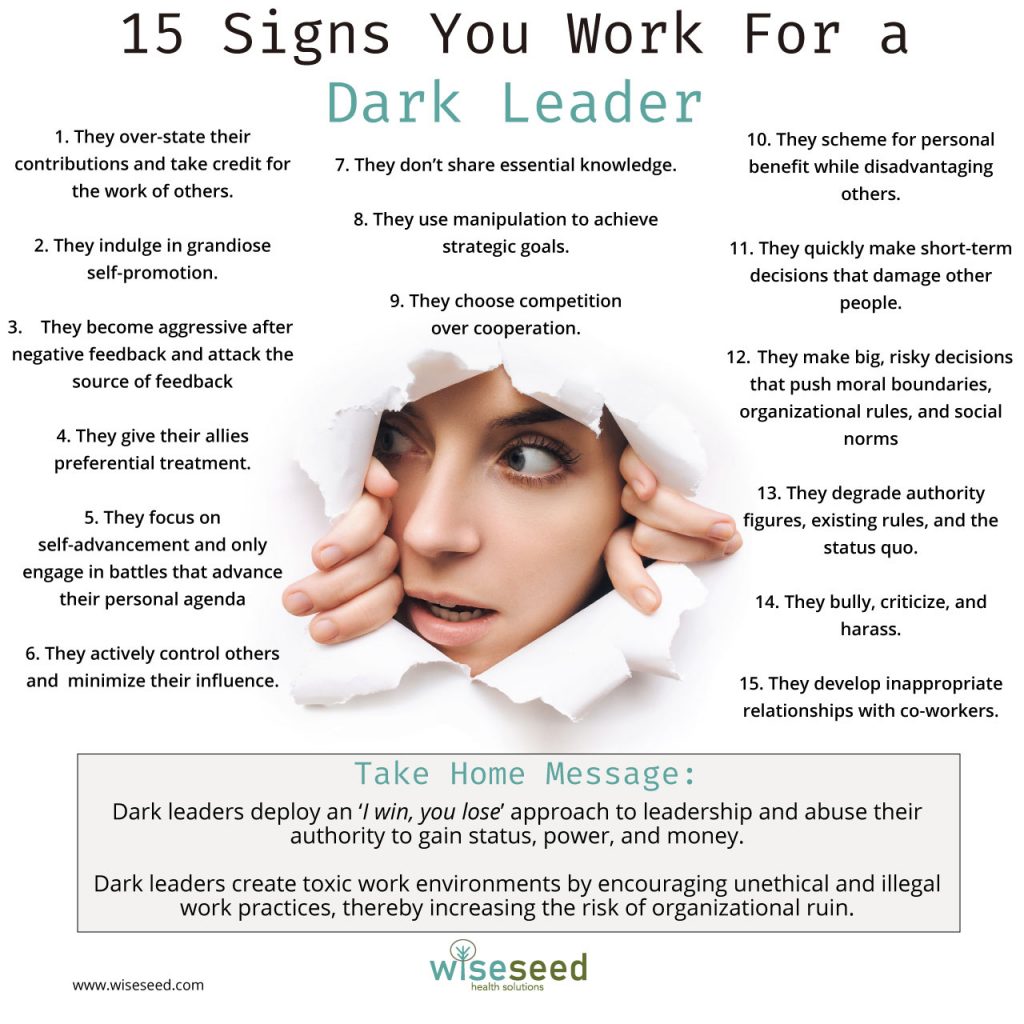Dark Leaders, Dark Future

“Rebellion to Tyrants is Obedience to God”
Benjamin Franklin
Introducing the Dark Humans
Unlike most people, dark humans are driven by selfishness and callousness (1).
Selfishness is the desire to maximize their own needs, desires, and goals above others. In contrast, callousness is the willingness to either disregard or actively oppress other people’s needs, desires, and goals (1).
In essence, dark humans embody an ‘I win, you lose’ approach to life, focusing on gaining social dominance (2). Status, hedonism, power, and money are the preferred outcomes for the dark human.
And for better or worse (and here I argue for worse), many dark humans hold leadership positions (3).
The Dark Triad
There are three well-studied manifestations of dark humans, collectively known as the Dark Triad.
1. The Narcissist
The defining personality traits of the narcissist are a heightened sense of entitlement, uniqueness, self-importance, and superiority (4).
There are two well-accepted types of narcissistic personalities. The first is the ‘vulnerable’ or ‘covert’ narcissist. The covert narcissist uses self-sabotage and victimhood to inflate their sense of entitlement, uniqueness, and importance (4). Fortunately, the self-sabotaging nature of the covert narcissist prevents them from acquiring leadership roles.
In contrast, the grandiose narcissist enjoys a sense of ‘personal superiority and entitlement, overconfidence, grandiosity, a willingness to exploit others for self-gain, and hostility and aggression when challenged” (4).
Alas, the grandiose narcissist has a long and established track record of acquiring leadership roles, often with disastrous results (4).
2. The Machiavellian
Machiavellians are cunning manipulators who cynically exploit other people (5). The hallmarks of the Machiavellian are the strategic use of flattery, lies, and manipulation for selfish personal gain (5). In addition, Machiavellians like to plan, build alliances, and maintain a positive reputation (5).
The defining elements of Machiavellianism are strategic manipulation, callousness, and alliance building (5). Thus, the skillful Machiavellian is well equipped to ascend professional hierarchies and assume positions of power and influence.
3. The Psychopath
Dark humans with psychopathic traits are cold individuals with low empathy who demonstrate little to no impulse control or remorse (6). Psychopathic dark humans routinely use aggression, intimidation, and sometimes violence to achieve their goals (6). Dark humans with psychopathic personalities seek leadership positions ‘because of their desire to access the associated power, influence, prestige and money.’ (3).
However, due to their impulsive and destructive nature, one would predict that psychopaths are unlikely to be promoted to leadership positions. And yet careful assessment revealed that corporations have a high prevalence of psychopaths working in upper management positions (6).
For example, within corporate environments, 5.9% of participants were identified as “potential” or “possible” psychopaths, compared to just 1.2% within the community at large (6). Further, 3% of the participants in corporations scored high-level psychopathy, compared with only 0.2% within the community sample (6). Worst of all, many individuals who scored highly for psychopathy held senior management positions (i.e., vice presidents, supervisors, and directors) (6)!
Thus, people having high-to-very high levels of psychopathy regularly rise to the top within large organizations (3, 6).
Why Do Dark Humans Obtain Leadership Roles?
Political Environment + Political Skill = Success
Two essential factors assist dark humans to assume leadership positions. First is the presence of a corruptible political environment within the organization (5).
The second piece of the puzzle is the dark leader’s political skill (5). Dark leaders who understand their political environment can readily identify situations that are open to exploitation (7).
Importantly, dark humans with high levels of political skill appear sincere and honest while building networks of influence. They then use their networks to access information, assess the social norms of their organizations, and influence the political environment in their favor (7).
Thus, a favorable (i.e., corruptible) political environment combined with high levels of political skill allows dark humans to achieve leadership positions despite poor objective performance at their Job (7).
Depressingly, the combination of a favorable political environment and political savvy likely explains why so many of our elected leaders are dark humans (2).
Dark Personality Traits Can Provide Competitive Advantage in Highly Chaotic and Rapidly Changing Environments
While dark humans are at a a competitive disadvantage over the long term due to their objectionable behavior and selfish choices, they enjoy a sizeable competitive advantage during periods of uncertainty and rapid change.
For example, dark personalities tend to perform well under pressure due to a combination of hyper-competitiveness (8), an orientation towards self-improvement (8), and a willingness to cheat (9). Furthermore, dark personalities are willing to take risks that many people aren’t, especially with other people’s money (3, 4).
Finally, successful dark personalities often display superior communication, persuasion, and interpersonal skills (3, 4). Moreover, because successful dark humans can combine high levels of creative thinking with a willingness to steal other people’s ideas, they often appear as transformational leaders (3, 4).
Thus, the combination of hyper-competitiveness, risk-taking, creative thinking, and interpersonal skills provides successful dark personalities a competitive advantage in many organizations.
The Presence of Counter-Balancing Bright Characteristics
It’s easy to caricature dark humans as one-dimensional villains straight from a comic book. However, human personalities are complex and binary thinking provides a poor guide to understanding the dark leader.
Fortunately, a clearer picture of dark leaders emerges when they are assessed for both light and dark personality traits.
For example, a recent study revealed a “dark” trait profile (dominated by malignant personality traits), a “light” trait profile (dominated by positive personality traits), and a “middle” subtype that expressed bright and dark personality traits in roughly equal measure (2). Further, even dark humans display some degree of bright traits, albeit at a much-reduced level compared to the bright and middle personalities (2).
Thus, dark leaders likely possess sufficient “light” personality traits to successfully work within groups (at least for a short time) and then assume leadership positions.
Dark Consequences
Dark Leaders steer their organization towards success only on rare occasions. One notable example is Steve Jobs, who helped build Apple into a global tech giant (10).
While Jobs is often considered a transformational leader, his biographer revealed a darker side (11). For instance, Jobs humiliated other people, was impulsive, took credit for others’ work, and lied (11). Furthermore, Jobs excelled at feigning modesty when required (11). Nevertheless, Steve Jobs possessed an epic set of leadership skills that clearly trumped his malignant narcissism (10).
However, as the superb leadership ability of Steve Jobs is exceedingly rare, the successful dark leader is the exception rather than the norm. Rather, study after study has confirmed that dark leaders have an overwhelmingly negative impact on the organizations they lead (3, 4, 12).
Toxic Work/Social Environment
When Dark Leaders rule, a toxic work environment soon emerges (3, 4, 12).
Dark leaders:
- Increase workplace bullying and harassment
- Reduce group performance and the retention of talented employees
- Increase workplace deviance
- Increase worker stress
- Decrease worker creativity, well-being, and job satisfaction
- Damage the career prospects of their employees
You can identify Dark leaders and their followers if they consistently display features summarized in the infographic below (adapted from (13))
Criminality
Dark leadership increases the rate of unethical and criminal activity within organizations. For example, dark leaders regularly engage in financial misreporting and corporate fraud, leading to an increased risk of litigation (3, 4, 12).
Naturally, under dark leaders, other forms of criminality also flourish.
A striking example is the founder of Uber, who claimed to be “creating a workplace where a deep sense of justice underpins everything we do” (4). Instead, Uber became a company that routinely violated social norms and laws, including the normalization of sexual harassment (4).
Ruin
By creating a toxic work environment and normalizing fraud and other forms of criminality, dark leaders significantly increase the risk of ruin.
Take the case of Enron. Between 1998-2000, Enron ranked as the seventh-largest Fortune 500 company (14), with Fortune magazine naming Enron as America’s most innovative company for six consecutive years (15). However, hiding behind the successful corporate façade lay a corporate culture of arrogance, greed, and fraud that eventually drove Enron bankrupt (14).
Take-Home Message
Dark leaders deploy an ‘I win, you lose’ approach to leadership and abuse their authority to gain status, power, and money.
Thus, organizations led by dark leaders are toxic work environments characterized by unethical and often illegal work practices, which in the long-term greatly increases the risk of ruin.

References and Further Reading
1. D. L. Paulhus, S. R. Curtis, D. N. Jones, Aggression as a trait: the Dark Tetrad alternative. Current Opinion in Psychology 19, 88-92 (2018).
2. C. S. Neumann et al., Light and dark trait subtypes of human personality – A multi-study person-centered approach. Personality and Individual Differences 164, 110121 (2020).
3. C. Boddy, Corporate Psychopaths Organizational Destroyers. (London: Palgrave Macmillan UK : Imprint: Palgrave Macmillan, ed. 1st ed. 2011., 2011).
4. C. A. O’Reilly, J. A. Chatman, Transformational leader or narcissist? How grandiose narcissists can create and destroy organizations and institutions. California Management Review 62, 5-27 (2020).
5. M. A. Baloch et al., Dark Triad, Perceptions of Organizational Politics and Counterproductive Work Behaviors: The Moderating Effect of Political Skills. Front Psychol 8, 1972-1972 (2017).
6. P. Babiak, C. S. Neumann, R. D. Hare, Corporate psychopathy: Talking the walk. Behav. Sci. Law 28, 174-193 (2010).
7. W. A. Hochwarter et al., Perceptions of Organizational Politics Research: Past, Present, and Future. Journal of Management 46, 879-907 (2020).
8. R. S. Vaughan, D. J. Madigan, The winner takes it all: The mediating role of competitive orientations in the Dark Triad and sport task performance relationship. European Journal of Sport Science 21, 1183-1192 (2021).
9. A. R. Nicholls et al., Cheater, cheater, pumpkin eater: the Dark Triad, attitudes towards doping, and cheating behaviour among athletes. Eur J Sport Sci 20, 1124-1130 (2020).
10. W. Isaacson, The real leadership lessons of Steve Jobs. Harvard Business Review 90, 92-102 (2012).
11. W. Isaacson, Steve Jobs. (JSTOR, 2021).
12. B. E. Kurtulmus, The Dark Side of Leadership: An Institutional Perspective. (Cham: Springer International Publishing AG, Cham, 2019).
13. B. Schyns, B. Wisse, S. Sanders, Shady Strategic Behavior: Recognizing Strategic Followership of Dark Triad Followers. Academy of Management Perspectives 33, 234-249 (2019).
14. R. Muhammad Mustafa, Case analysis: Enron Ethics, social responsibility, and ethical accounting as inferior goods? Journal of Economics Library 7, 97 (2020).
15. E. Eckhaus, Z. Sheaffer, Managerial hubris detection: the case of Enron. Risk Management (Leicestershire, England) 20, 304-325 (2018).
Acknowledgments
Images created by Oleksandr Shchus and Albina Gavrilovic
Disclaimer
The material displayed on this website is provided without any guarantees, conditions or warranties as to its accuracy.
Information written and expressed on this website is for education purposes and interest only. It is not intended to replace advice from your medical or healthcare professional.
You are encouraged to make your own health care choices based on your own research and in conjunction with your qualified practitioner.
The information provided on this website is not intended to provide a diagnosis, treatment or cure for any diseases. You should seek medical attention before undertaking any diet, exercise, other health program or other procedure described on this website.
To the fullest extent permitted by law we hereby expressly exclude all warranties and other terms which might otherwise be implied by statute, common law or the law of equity and must not be liable for any damages whatsoever, including but without limitation to any direct, indirect, special, consequential, punitive or incidental damages, or damages for loss of use, profits, data or other intangibles, damage to goodwill or reputation, injury or death, or the cost of procurement of substitute goods and services, arising out of or related to the use, inability to use, performance or failures of this website or any linked sites and any materials or information posted on those sites, irrespective of whether such damages were foreseeable or arise in contract, tort, equity, restitution, by statute, at common law or otherwise.

Ten Minutes is All You Need
Research has shown that ten minutes of moderate-to-vigorous exercise performed each day is enough to significantly reduce your risk of early death.

The Way of the Weekend Warrior
The way of the weekend warrior is one path to health that also leaves plenty of room in your life for the pursuit of other activities that you find important and meaningful.




